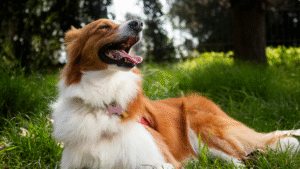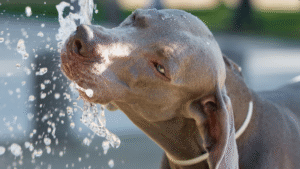Getting your dog’s coat shiny and healthy might sound like a simple task, but it’s not always easy. Dog coats vary by breed and size, requiring different types of maintenance and care. A shiny, thick, or soft coat is usually a reflection of a dog’s overall health.
A shiny and healthy coat also means your pet is properly nourished, well cared for, and generally happy. On the other hand, a dull, lifeless coat, brittle fur, or flaky skin can indicate poor nutrition or underlying health issues.
In this guide, we’ll look at everything you need to know to get your dog’s coat shiny and healthy.

1. Proper Nutrition Starts from the Inside
Feeding your dog a balanced diet with all the necessary nutrients is essential not only for their internal health but also for the condition of their skin and coat. If your dog’s coat has become dull, dry, or brittle, it may be a sign they’re not getting enough fatty acids, vitamins, or proteins.
Important nutrients to help your dog’s coat look shiny, soft, and healthy:
-
Omega-3 and Omega-6 Fatty Acids: These are some of the best nutrients for improving your dog’s coat from the inside out. Omega-3s reduce inflammation, while Omega-6 fatty acids help hydrate your dog’s skin, leading to softer, shinier fur. Omega-3s are found in fish oil and flaxseed, while Omega-6s are found in most meats and eggs. Salmon is another excellent source of fatty acids.
-
Protein: Not all dog food contains enough protein to support healthy fur growth. Choose high-quality dog food that lists real meat (such as chicken, beef, or lamb) as the first ingredient.
-
Vitamin E: This essential nutrient supports skin health and acts as a natural antioxidant, protecting your dog’s skin cells from damage.
-
Biotin and Zinc: These nutrients help keep hair follicles strong and healthy, preventing excessive shedding.
If your dog’s food is low in one or more of these nutrients, look for a higher-quality formula specifically designed for skin and coat health. A supplement like salmon oil or coconut oil can also help. Always consult your vet before adding any new supplement to your dog’s diet.
2. Hydration
Water is an often-overlooked aspect of a dog’s health and coat condition. While diet plays a major role in coat quality, hydration is a basic requirement for healthy skin and fur. A dehydrated dog is more likely to experience dry, flaky skin and a dull coat.
Tips for keeping your dog hydrated:
-
Always provide fresh, clean water.
-
Add water or low-sodium bone broth to meals if your dog doesn’t drink enough.
-
Ensure your dog has plenty of water, especially during hot weather or after exercise.
Proper hydration helps flush out toxins, lubricate the skin, and maintain normal body function—all of which are essential for shiny, healthy fur.

3. Regular Grooming Helps Remove Dirt and Stimulates Blood Flow
Brushing is one of the best things you can do for your dog’s coat. Beyond keeping your dog tidy and removing loose fur and dirt, brushing stimulates blood flow and spreads the skin’s natural oils throughout the coat.
Recommended brushing frequency:
-
Short-haired breeds: Once or twice a week
-
Medium-haired breeds: Every other day
-
Long-haired breeds: Daily, to prevent mats and tangles
Recommended brushes by coat type:
-
Bristle brush: For short-haired dogs
-
Slicker brush: For detangling and removing mats in long-haired breeds
-
Undercoat rake: For reducing shedding in double-coated breeds
Brush your dog gently but thoroughly to distribute natural oils evenly. This will give the coat a natural shine while preventing dryness and breakage.

4. Bathe Your Dog—But Don’t Overdo It
Regular bathing keeps your dog’s coat clean and free from excess oils and dirt, but too much bathing can strip away the natural oils that maintain shine. Overbathing can also irritate the skin and cause a dull coat.
How often to bathe your dog:
-
In most cases, once every 4–6 weeks is enough.
-
Dogs that spend a lot of time outdoors or have allergies may need more frequent baths.
Always use dog-specific shampoos, as human products can dry your dog’s skin or disrupt its natural pH balance. Look for natural, moisturizing shampoos with ingredients like oatmeal, aloe vera, or coconut oil.
Tip: Use a conditioning rinse or detangling spray after bathing to lock in moisture and make brushing easier.
5. Manage Allergies and Skin Conditions
If your dog’s coat remains dull despite a proper diet and regular grooming, the cause may be an underlying allergy or skin condition. Allergies can be triggered by food, environmental factors, or parasites, all of which can cause dry, flaky, or dull skin and coat.
Common signs of allergies or skin issues:
-
Persistent scratching or licking
-
Dry, flaky, or irritated skin
-
Red patches or sores
-
Dull, greasy, or foul-smelling coat
Only a veterinarian can determine whether your dog has an allergy or infection. Schedule an appointment if you notice any of these symptoms. Your vet may prescribe topical treatments or recommend dietary changes to rule out food-related causes.

6. Keep Parasites at Bay
Frequent flea or tick infestations can cause a dull, patchy, or damaged coat. Fleas, ticks, and mites irritate the skin, leading to scratching, hair loss, and infections. Some parasites can even spread diseases to your dog.
To prevent parasites:
-
Use vet-recommended flea and tick prevention treatments year-round.
-
Clean your dog’s bedding regularly and vacuum your home often.
-
Follow your vet’s advice on parasite control, even for indoor dogs.

7. Exercise and Mental Stimulation Boost Coat Health
A dog’s physical and mental health directly affect their coat condition. Stress, anxiety, or boredom can cause hormonal imbalances that lead to coat or skin problems.
Regular walks, playtime, and interactive games help your dog release energy, reduce stress, and maintain hormonal balance—all of which promote a healthy, shiny coat.
Engage your dog with activities such as learning new tricks, puzzle toys, or agility training. Social interaction and regular playtime with other dogs or family members also contribute to overall well-being.
8. Use Natural Ingredients
Several natural ingredients can help enhance your dog’s coat shine, both as dietary supplements and topical treatments.
Effective natural options include:
-
Coconut Oil: Add small amounts to your dog’s food for essential fatty acids, or apply directly to their coat as a natural moisturizer.
-
Olive Oil: Adding one to two teaspoons to food a few times per week can improve skin and coat condition. It can also be used topically for moisture.
-
Apple Cider Vinegar Rinse: Mix one part vinegar with two parts water and use it as a post-bath rinse to restore pH balance and add shine.
Tip: Always test any new treatment on a small patch of skin first to check for irritation. Consult your vet before introducing new ingredients to your dog’s routine.
Final Thoughts
A shiny coat is a beautiful coat—and a reflection of your dog’s overall health. A thick, smooth, and lustrous coat shows that your dog is well-nourished and cared for, while a dull, lifeless coat can be a warning sign of nutritional or health problems.
To keep your dog’s coat shiny and healthy, provide a balanced diet, maintain regular grooming and bathing, ensure proper hydration, and schedule regular vet visits. You can also enhance your dog’s coat with natural oils or supplements for that extra shine.
- 5 Cheap Alternatives To Dog Training Equipment - November 12, 2025
- Homemade Calming Spray To Help Dogs During Training - November 12, 2025
- 7 DIY Dog Training Tools You Can Make From Household Items - November 12, 2025
